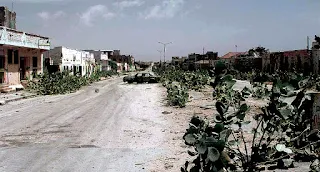Somalia for Travelers: What You Must Know About the Green Line
Somalia beyond the Green Line is still one of the most dangerous regions in the world.
The term Green Line once described a battle-scarred boundary slicing through Mogadishu during the height of Somalia’s civil war in the 1990's. It divided the capital between rival warlords Mohamed Farah Aideed and Ali Mahdi Mohamed and became a deadly front line of urban warfare, snipers, and relentless shelling. Though the physical line has long since disappeared through peace talks and power shifts, its legacy remains deeply etched into the political geography of Somalia.
Today, the phrase Beyond the Green Line is more than historical as it captures the reality of life outside the control of Somalia’s federal government, where Al-Shabaab militants, clan militias, and ungoverned spaces continue to challenge efforts at national unity and security. This article explores what lies beyond that line then and now.
Somalia beyond the Green Line is still one of the most dangerous regions in the world. Northern coastal Mozambique is an active insurgency zone, these areas are not suitable for tourism or casual travel. The Green Zone (airport area and government institutions in Mogadishu) has fortified access. Travel beyond this zone requires armored transport, armed escorts, and approval from local authorities.
 |
| What You Must Know About the Green Line |
Somalia Beyond the Green Line
What Is Beyond the Green Line in Somalia?
The term Green Line in Mogadishu refers to the boundary that historically separated government-controlled zones from those held by insurgents, particularly Al-Shabaab, the Islamist militant group affiliated with Al-Qaeda. Going beyond the green line today typically means entering unsecured, insurgent-dominated territories. Middle and Lower Shabelle, Bay, Bakool, and parts of Galmudug and Hirshabelle remain largely under Al-Shabaab influence.
Why It's Dangerous
Active conflict zones exist throughout southern and central Somalia. Al-Shabaab controls or contests territory, and frequently targets foreigners, aid workers, and even local civilians. Kidnapping is a known strategy and unfortunately foreign nationals are high-value targets.
There is no functioning national security apparatus in many areas and Airstrikes, IEDs, ambushes, and assassinations are common. Humanitarian corridors often close without notice due to conflict flare-ups. Overland routes from Mogadishu to the interior are frequently targeted by insurgents. The Afgoye corridor once a lifeline is now a conflict flashpoint.
Who Still Goes There?
War correspondents, embedded with private security of course. Humanitarian workers under UN or Red Crescent auspices along with Regional peacekeepers under AMISOM or ATMIS. Most embassies do not have consular services in Somalia, and evacuation in case of emergency is not guaranteed. For the average traveler, Somalia is not a tourist destination, not even close.
Mozambique: Coastal Cabo Delgado Beyond the Green Line
What’s Happening in Northern Mozambique?
Since 2017, the Cabo Delgado province, especially its northern and coastal zones (e.g., Mocímboa da Praia, Palma, and Quissanga), has seen violent insurgency from an extremist group called Ahlu Sunnah wa Jama’a, often referred to as ISIS-Mozambique. The phrase beyond the green line is sometimes used metaphorically in this context to refer to territory outside of state control, where insurgents operate freely.
Why It’s Risky
Waves of brutal attacks have occurred such as beheadings, kidnappings, and destruction of villages. To date there are over 4,000 deaths and 800,000 people displaced since 2017. Foreign workers on gas projects were evacuated after direct attacks. Most importantly insurgents use forests and coastline for guerrilla movements and escape routes.
Cabo Delgado Insurgency: Security Timeline and Map Summary
Timeline of the Cabo Delgado Insurgency
2017: Insurgency begins in October, centered around port towns like Mocímboa da Praia and Palme. Early attacks are concentrated in northeast Cabo Delgado.
2020: August: IS-linked militants seize Mocímboa da Praia in a major offensive. November: Over 50 civilians are beheaded in the Muatide massacre. The Muatide massacre stands out as one of the most horrific atrocities committed during the ongoing insurgency in northern Mozambique’s Cabo Delgado province. It involved the brutal beheading of over 50 civilians, including women and children.
2021: April-October: The Battle of Mucojo was a prolonged, high-stakes conflict in coastal northern Mozambique, fought between Islamist insurgents and a combined force of Mozambican soldiers, Rwandan troops, and Southern African Development Community (SADC) forces. It took place between April and October 2021 in the town of Mucojo, located in Macomia District, Cabo Delgado province. Mid-year: Rwanda and SADC deploy forces to assist Mozambique.
2022: Facing military pressure in coastal areas, insurgents retreated inland into Mueda and Meluco, shifting to guerrilla tactics. Some fighters crossed the border into Tanzania, expanding the conflict's reach beyond Mozambique. Attacks continue with hit-and-run guerrilla tactics.
2023-2024: Active insurgents drop from 2,500 to around 280, but violence persists. Jan 2024: Mucojo temporarily reoccupied by insurgents. February 2024: 25 soldiers killed at a military post. March 2024: Quirimba Island taken, residents flee to Pemba. September 2024: Government forces recapture Mucojo.
2025: May 18, 2025: A suicide bomber struck recruits at the Damaanyo military base, killing at least 20 and injuring 15. July 9, 2025: A bomb-and-shooting attack at Jaalle Siyaad Military Academy killed four soldiers and injured others, exposing vulnerabilities in high-security installations. Suicide bombings, kidnappings and targeted assassinations within Mogadishu have highlighted security gaps within supposedly fortified zones.
Beyond the Green Line
Part of our African Geography Hub — discover how Africa’s land, people, and natural features shape its story.

























